Marsh Baldon
| Marsh Baldon | |
| Oxfordshire | |
|---|---|
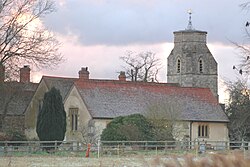 St Peter's parish church | |
| Location | |
| Grid reference: | SU5699 |
| Location: | 51°41’24"N, 1°11’2"W |
| Data | |
| Population: | 310 (2011) |
| Post town: | Oxford |
| Postcode: | OX44 |
| Dialling code: | 01865 |
| Local Government | |
| Council: | South Oxfordshire |
| Parliamentary constituency: |
Henley |
| Website: | Baldons Parish Council |
Marsh Baldon or March Baldon is a village and parish in the Bullingdon Hundred of Oxfordshire, about five miles south-east of Oxford. The 2011 Census recorded its population as 310.[1] Since 2012 it has been part of the Baldons joint parish area, sharing a parish council with the adjacent civil parish of Toot Baldon.
Archaeology
The course of the Roman road that linked Dorchester on Thames with Alchester passes through the parish on a north-south axis, and the eastern boundary of the village green approximately follows it.[2] Roman coins and Romano-British pottery have been found in the parish.[2]
About a mile south of the village, just east of the Golden Balls roundabout on the A4074 road, is the site of a set of Roman kilns.[3] The site is now a scheduled monument.[3]
Manor
In the 11th century a Saxon called Azur held a manor of 10 hides at Marsh Baldon.[2] After the Norman conquest this manor was one of numerous estates granted to Miles Crispin, a Norman baron who may have been the first castellan of Wallingford Castle.[2] Marsh Baldon remained part of the Honour of Wallingford until at least 1166.[2]
Baldon House was built in the 17th century[4] or earlier as the manor house.[5] It was extended in the 18th century,[4] and wings were added in the 19th and early in the 20th centuries. Baldon House is a Grade-II* listed building.[5]
Parish church
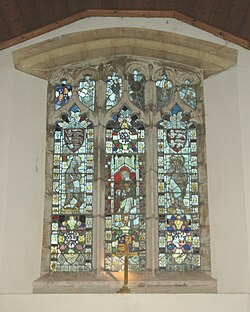
The Church of England parish church of Saint Peter dates from the 12th century, with 14th- and 15th-century alterations.[6] St Peter's was restored in 1890 by the architect Somers Clarke and builder J.T. Micklethwaite.[6] It is a Grade II* listed building.[7]
Above the south portal is a very fine example of a 12th-century canonical sundial.
In the north aisle is a painting of the Annunciation by the Italian master Pompeo Batoni] (1708–87) after Guido Reni.[6] It hung in the chapel of Corpus Christi College, Oxford until 1794, when Sir Christopher Willoughby had St Peter's church remodelled and donated the painting.[6] Marsh Baldon is not the only Oxfordshire parish church to have a painting by Batoni. The parish church of the Blessed Virgin Mary, Weston-on-the-Green, 12 miles north of Marsh Baldon, has a Batoni altarpiece of the Ten Commandments.[8]
St Peter's 14th-century bell tower[6] has a ring of five bells,[9] the oldest of which was cast by John White of Reading, Berkshire[10] in about 1480.[9] Ellis I Knight of Reading[10] cast two more, including the tenor bell, in about 1628.[9] Mears and Stainbank of the Whitechapel Bell Foundry[10] cast another bell in 1902 and finally the treble bell in 1954.[9] There is also a Sanctus bell that was cast in about 1760 by Robert Wells[9] of Aldbourne, Wiltshire.[10]
Economic and social history
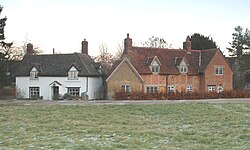
Most of Marsh Baldon's houses and cottages are arranged around the village green, which is an irregular square shape with an area of more than an acre.[11] The green is common land that was used for grazing. Until the 20th century the road through Marsh Baldon was gated at both ends of the village to prevent livestock from straying.[12]
It may be that the earliest settlement was clustered around St. Peter's church.[11][12] The large green north-east of this original settlement would subsequently have been reclaimed from marshland early in the Middle Ages and then surrounded by houses.[11][12]
School
The parish has a Church of England primary school. It was founded at Toot Baldon in 1771, when Elizabeth Lane left the house and four acres of land at Herbert's Farm for the purpose.[2] The farmhouse accommodated the schoolmaster, the four acres were for a site for the school and an orchard as its endowment.[2] Elizabeth Lane's bequest funded free education for six boys and six girls; other families paid fees for the school to educate their children. By 1866 the school had 56 pupils.[2]
The present building at Marsh Baldon was erected in 1873 and a second classroom was added in 1897.[2] In 1929 the school was reorganised for junior pupils only, with children over 11 years old going to the Church of England school at Dorchester on Thames from then onwards.[2] The number of pupils enrolled in the reorganised school rose from 40 in 1929 to 52 in 1952.[2]
Amenities
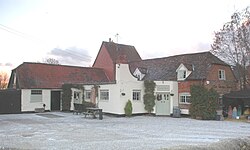
Marsh Baldon has a public house, the Seven Stars.[13] Marsh Baldon and Toot Baldon share a cricket club.[14]
In the south-east of the parish, next to the boundary with Nuneham Courtenay, are two woods: Old Common and Bluebell Wood. The latter contains Harcourt Arboretum, which is part of the University of Oxford's Botanic Garden.
References
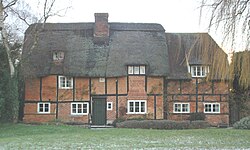
- ↑ "Area: Marsh Baldon (Parish): Key Figures for 2011 Census: Key Statistics". Neighbourhood Statistics. Office for National Statistics. http://www.neighbourhood.statistics.gov.uk/dissemination/LeadKeyFigures.do?a=7&b=11126355&c=Marsh+Baldon&d=16&e=62&g=6459277&i=1001x1003x1032x1004&m=0&r=1&s=1432729331862&enc=1. Retrieved 27 May 2015.
- ↑ 2.00 2.01 2.02 2.03 2.04 2.05 2.06 2.07 2.08 2.09 2.10 Lobel 1957, pp. 30–47.
- ↑ 3.0 3.1 National Heritage List 1006337: Site of Roman kilns
- ↑ 4.0 4.1 Sherwood & Pevsner 1974, p. 699.
- ↑ 5.0 5.1 National Heritage List 1048058: Baldon House Baldon House East Wing Baldon House West Wing (Grade II* listing)
- ↑ 6.0 6.1 6.2 6.3 6.4 Sherwood & Pevsner 1974, p. 698.
- ↑ National Heritage List 1048056: Church of St Peter (Grade II* listing)
- ↑ Sherwood & Pevsner 1974, p. 833.
- ↑ 9.0 9.1 9.2 9.3 9.4 Davies, Peter (12 October 2007). "Place: Marsh Baldon S Peter". Dove's Guide for Church Bell Ringers. http://dove.cccbr.org.uk/detail.php?searchString=Marsh+Baldon&numPerPage=10&Submit=Go&searchAmount=%3D&searchMetric=cwt&sortBy=Place&sortDir=Asc&DoveID=MARSH+BALD. Retrieved 16 December 2010.
- ↑ 10.0 10.1 10.2 10.3 Dovemaster (25 June 2010). "Bell Founders". Dove's Guide for Church Bell Ringers. http://dove.cccbr.org.uk/founders.php. Retrieved 16 December 2010.
- ↑ 11.0 11.1 11.2 Rowley 1978, p. 33.
- ↑ 12.0 12.1 12.2 Rowley 1978, p. 35.
- ↑ The Seven Stars
- ↑ The Baldons Cricket Club
Sources
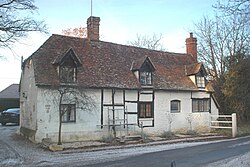
- Lobel, Mary D, ed (1957). A History of the County of Oxford: Volume 5: Bullingdon Hundred. Victoria County History. pp. 30–47.
- Rowley, Trevor (1978). Villages in the Landscape. Archaeology in the Field Series. London: J.M. Dent & Sons Ltd. pp. 33, 35. ISBN 0-460-04166-5.
- Sherwood, Jennifer; Pevsner, Nikolaus (1974). Oxfordshire. The Buildings of England. Harmondsworth: Penguin Books. pp. 698–699. ISBN 0-14-071045-0.
Outside links
| ("Wikimedia Commons" has material about Marsh Baldon) |
